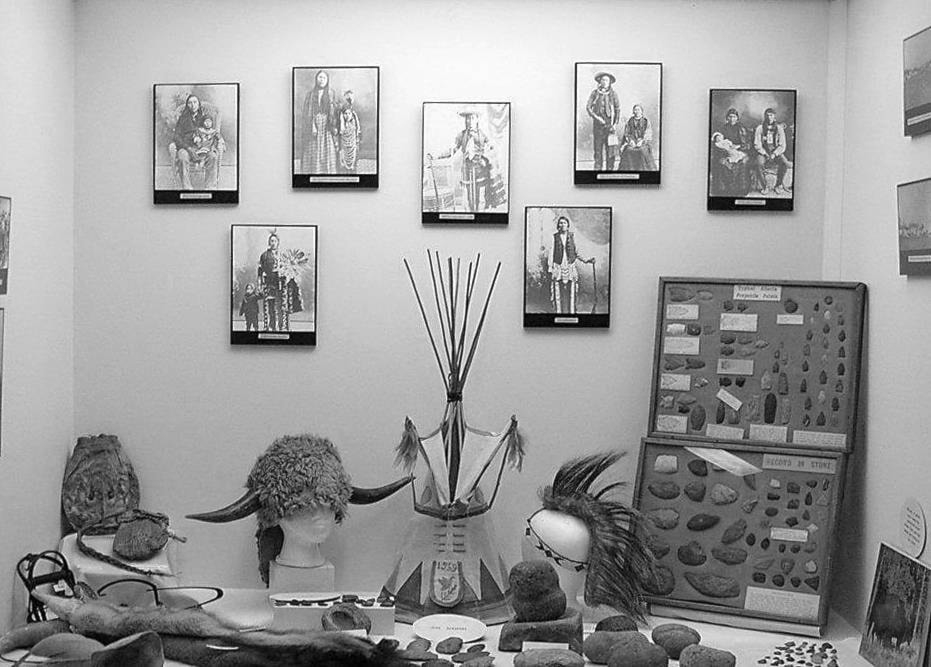By Mike Rainone for the News
One corner of the delightful display room at the Fort Ostell Museum (FOM) in Ponoka has been devoted to the long and colourful history and proud culture and heritage of our First Nations.
Two powerful displays are now open to the public and feature an exciting story and collection of photos, tools, clothing, classic bead work, and other artifacts and items that represent several centuries of the proud traditions and amazing contributions of the First Nations community in this area and across the vast Canadian west. As far back as our age-old history books may go we are told that it was the First Nations who were the first inhabitants of the thousands of miles of lush and rolling landscape, and it was these hardy people, who explorer Anthony Henday would look forward to seeing in 1754 when he became the first person to enter into what is now the province of Alberta.
The most definite record of the early First Nations to inhabit the Battle River country came in the 1730s when the Shoshoni or Snake tribes came into the area, but then over countless decades the Chipweyan, Cree, Blackfoot, Stony, and others hunted and roamed free in the vast expanse from Pigeon Lake to Buffalo Lake as well as throughout the province and into the United States.
The excellent family display pays tribute in photos to the supreme efforts, leadership, and dedication throughout the decades of some of the early chiefs, families, and individuals, including Chiefs Muddy Bull, Bobtail, Samson, Ermineskin, Baptiste Saddleback, Robert Stoney and son, Sam Saddleback, Eva Cutknife’s grandma and child, Boise Samson and child, and there were, and have been so many others along the way. Also featured in the colourful showcases are local newspaper pictures and stories of the early 19th century First Nation camps that were hosted on the east side of the Battle River near Ponoka, which were also highlighted by bartering and trade along with a gala Pow-wow in front of Algar’s Store, in which everyone took part. These authentic and exciting displays also include a Buffalo Horn headdress that was worn by a late 1800s plains Cree medicine man, a porcupine hair roach worn by the male dancers, as well as an authentic sample of porcupine guard and white tail deer hair.
In order to realize the amazing skills and ability of these hardy generations of First Nations men, women, and children to create, adjust, and survive all the conditions and challenges of the rugged Alberta prairies, visitors to the Fort Ostell Museum will appreciate this wonderful and historic display of: hide scrapers, moccasins, bead-work, typical Alberta arrow-heads, hammer and axe heads, thumb and hide scrapers, horn scoops and powder horn, personal property bags, sweet grass, pelican powder, a hand-made model canoe, and so much more.
The First Nations were also extremely skilled hunters and the new FOM display vividly features some of the traps and weapons they fashioned and utilized to hunt the millions of Buffalo and other plentiful wild game from which they took only what was required to supply the meat, the hides, and whatever else that was required to survive and feed their families during their endless travels and settlement in this vast and ever-challenging land. Their ongoing dedication and support then and now to the growth and successes of our towns and counties, our province, our nation, and the world should always be appreciated and celebrated. At the present time there are 45 First Nations in Alberta.
World Class Museum display coming here this year
Fort Ostell Museum staff Sandy Allsopp and Sharon Chapman and the Museum Board are pleased to announce that they will be hosting the memorable National Travelling Exhibition From Vimy to Juno; Canada in France (1914-1945) from Sept. 10th to 28th.
The vivid and action-packed display will be bringing the vital legacy of Vimy Ridge and Juno Beach to Canadians across our nation, and everyone is welcome to drop in whenever they wish as well as attend a special Open House showing event on Friday, Sept. 14th. Please feel welcome to browse through the unique displays and thousands of items that are all dedicated to the exciting and colourful town and county history and rugged founding pioneers.
The Fort Ostell Museum at 5320-54th Street at the north end of the Ponoka Lions’ Centennial Park is now operating on winter hours from 1 to 4 p.m. on Tuesdays to Thursdays. After the Victoria Day weekend in May the summer hours at the Museum are from 10 a.m. to 5 p.m. on Tuesdays to Fridays, 1 to 5 p.m. on Saturdays and holiday Mondays. Tours and special events for groups and school classes are also arranged and hosted by the museum’s congenial staff and summer students.
For more information please drop in or call 403-783-5224, or email: FOM01@telus.net.
